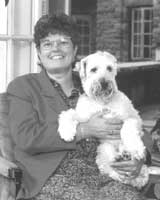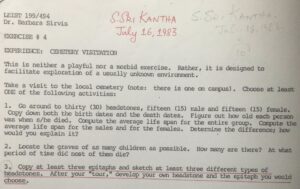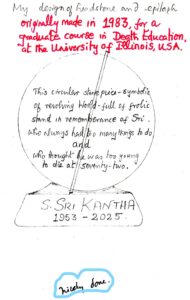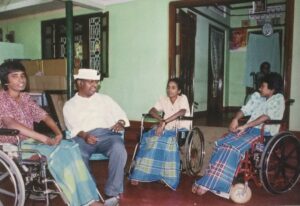Preparing my Tombstone and Epitaph in 1983
by Sachi Sri Kantha, May 12, 2025
2025 – This is the year, in which I had predicted my death in 1983! Please check my design of tombstone and epitaph presented nearby. I was 30 then. Now I look back about that episode here.
A Death Education course in 1983

Barbara Sirvis
I followed a stimulating summer course at the University of Illinois. The instructor was visiting professor Barbara Sirvis. The main theme was ‘Death Education’. I had passed my 30th birthday then. Here are some excerpts of my impression, as recorded in my diary.
July 7, 1983 – Thursday: The second day of the LEIST.494 class. Barbara showed us a movie ‘How could I not be among you?’ characterizing the 32 year old poet, Ted Rosenthal, who had died of leukemia.
July 12, 1983 – Tuesday: During the Death Education class, Barbara provided some new concepts of teaching. She asked us to form in pairs, and act as role models for a health personnel and a terminally ill patient; and health personnel trying to convey to the patient that he/she is going to die. I teamed up with Jean; and she was the doctor and I was the patient. It was a lesson of proxemics, and silent language too.
Made my way to Health Science library to pick up a suitable topic for my long assignment on Death Education. Finally settled on to the topic ‘Definition of Death – an annotated bibliography’. I wonder, if I collect sufficient data. I could write an essay on this topic.
July 14, 1983 – Thursday: Barbara had invited a guest speaker. He was Steve Morgan, one of the Funeral Directors of the Mittendorf Funeral Home. It was more illuminating and entertaining to listen to a funeral director, who had to overcome and do his business during the times of grief.

Cemetery Visitation Experience assignment, July 1983
July 16, 1983 – Saturday: In the morning went to the Mount Hope Cemetery, to complete my weekend assignment for the course. It was somewhat a new experience to search through the headstones to locate those with epitaphs. This exercise give me new impetus to look toward carrying out untouched field of research.
July 18, 1983 – Monday: With Barbara Sirvis, Terry and Salie, went to the Mittendorf Funeral Home, for a field tour – lecture. This is the first time I’ve visited a funeral home in USA. One of the directors, Steve, described to us the formalities and intricacies of operating the funeral home. Amazed to see the different type of caskets, with the lowest rate for $150 to highest of approx. ~$3,100. I’m becoming convinced that, even to die in America, it will be very costly. Imagine, if I die here, and my body to be taken to Sri Lanka, it would cost at least $3,000. Hope, it won’t occur to me. I wish that, I would have seen the embalming, which we couldn’t. Today only I learnt the basics of embalming process, that it is essentially draining out the blood from blood vessels and replacing it with embalming fluid. When I asked him about the composition of the embalming fluid, Steve mentioned though it normally remains as a secret, the usual ones are, formaldehyde and glutraldehyde.
July 19, 1983 – Tuesday: We watched the movie, ‘You see, I’ve had a life’, and the related topic of the discussion was ‘Death and Children’.
July 21, 1983 – Thursday: We saw a movie, titled ‘Peege’, and the topic of today’s discussion was ‘Death and Aging’.
July 26, 1983 – Tuesday: During the class intermission, my Australian friend Brian mentioned that he heard in today’s morning BBC news, that there had erupted ethnic riots in Sri Lanka, after a dozen of soldiers were killed. After I heard this news, I couldn’t concentrate on the class further. I was thinking for venues to get more info. But, whom can I contact?
After a lapse of few weeks, bought ‘USA Today’ paper. Under the World News column, it had a news story ‘Sri Lanka: 60 reported killed in ethnic rioting’. But, it didn’t have much of the details.
July 28, 1983 – Thursday: Today, Jan Shepherdson was the guest speaker. She talked to us on the hospice program, and Jan is from Mercy Hospital. There are volunteer opportunities to serve at hospital. If only I could find some time?
At 5:30 pm, made my way to Barbara Sirvis’s house. There were seven of us for a barbecue dinner. After dinner, we watched a videotape movie ‘Who’s Life is it anyway?’ starring Richard Dreyfuss. It was enjoyable, related to death education. We had a short discussion after that.
July 30, 1983 – Saturday: Typed the annotated bibliography on the definition of death assignment, due for Tuesday.
Aug 2, 1983 – Tuesday: Penultimate day of class. Handed over the prepared assignment. This accounts for 100 points. Hope, I’ll get maximum points; and today we’re given the Take Home Final exam, which we have to complete and return by Thursday, by 5:00 pm. Now, for two nights, I have to work on this.
August 4, 1983 – Thursday: The last day of class. Handed the Take Home Final exam. Dr. Sirvis ended the class in a healthy note. I enjoyed this course thoroughly, and hope I’ll be rewarded with an A grade.

Cemetery Visitation: My Tombstone and Epitaph
I expand on the July 16, 1983 assignment described above in the diary entry. It was Exercise #4: Cemetery Visitation. I provide an image of it nearby.
“This is neither a playful nor a morbid exercise. Rather, it is designed to facilitate exploration of a usually unknown environment.
Take visit to the local cemetery (note: there is one on campus). Choose at least ONE of the following activities:
- Go around to thirty (30) headstones, fifteen (15) male and fifteen (15) female. Copy down both the birth dates and the death dates. Figure out how old each person was when s/he died. Compute the average life span for the entire group. Compute the average life span for the males and for the females. Determine the difference: how would you explain it?
- Locate the graves of as many children as possible. How many are there? At what period of time did most of them die?
- Copy at least three epitaphs and sketch at least three different types of headstones. After your ‘tour’, develop your own headstone and the epitaph you would choose.
- Do one neat, well-done gravestone rubbing.
Among the four listed above, I chose the number 3. What I prepared can be seen nearby. In it, I had set my year of death to 2025, after I reached 72. What I had written as my epitaph was seven lines, as follows
‘This circular stone piece – symbolic
of revolving world – full of frolic
stand in remembrance of Sri
Who always had too many things to do
and
Who thought he was too young
to die at Seventy two.’
I was happy that Barbara’s comment, seen at the bottom was ‘Nicely done’.
There were two reasons for my choice of year 2025. First was, my maternal grandfather Arumugam Thiyagarajah (1910-1982, Appah, for me) had died the previous year, at the age of 72. I couldn’t attend his funeral, as I didn’t have the means then for a round trip ticket from USA to Sri Lanka and back. Secondly, after reaching 30, I felt I was at the start line of a ‘marathon race’ for survival in this world. So, I added the marathon race distance of 42 km to my then age of 30. The life expectancy for a male baby born in 1953 was only 58 years. I yearned to live for another 10+ years. Now, my wish had been granted. By God’s grace, I’ve survived until 72.
I was introduced to the concept of death by Swiss-American psychiatrist Elisabeth Kubler-Ross (1926-2004) in this course. Her identification of five steps path to comprehend the death process (denial, anger, bargaining, depression and acceptance) was indeed a beauty. Having touched the 72 year limit that I had set in 1983, when the Grim Reaper calls on me, I’m now prepared to jump to the final step of ‘acceptance’ in Kubler-Ross’s scale. God only knows, how long I can live. I may extend my aim for another 8 years, to reach 80. That was the limit, my father Sachithanantham reached.
Re-winding My Life
Maybe, it’s time to re-wind my life until now. I had enjoyed a kaleidoscope of careers since 1972. My list of professional work (for which remuneration/compensation were paid) cumulates to 21 different services to the community. In tentative chronological order, these were as follows:
✧Flute teacher to primary school students (1972-77)
✧Graded radio program artiste in flute (1972-80)
✧Back orchestra flutist for dance programs (1972-77)
✧Temporary university instructor [lab demonstrator, assistant lecturer at University of Colombo, University of Peradeniya] (1976-80)
✧High school student tutor in zoology (1976)
✧Graduate research assistant in biochemistry, food chemistry [University of Peradeniya, University of Illinois- Urbana, Champaign] (1980-85)
✧Postdoctoral research associate [University of Tokyo, Medical College of Pennsylvania, Osaka Bioscience Institute] (1986-94)
✧Tokyo science correspondent for South magazine (1988)
✧Book reviewer for Mainichi Daily News, Asahi Evening News papers (1988-91)
✧Bibliographer of Japanese whaling research ((1989-90)
✧Published author of reference books for Greenwood Press (1991-96)
✧Commissioned Japanese-English translator of a reference book for Oxford University Press (1998)
✧Food biochemist (1995-2000)
✧Associate Professor/Visiting Professor [Gifu University, Kyoto University, Gifu Pharmaceutical University] (2000 – 2018)
✧Specialist consultant on Sri Lankan affairs (2004-2008)
✧Editor in Chief for web science journal – Reviews in Agricultural Sciences (2016-2020)
✧Tutor for high school students with special needs (2019-21)
✧Specialist consultant on Alfred Nobel [Japanese national TV-NHK] (2020)
✧Clinical Medical Interpreter (2021 – present)
✧Adjunct Professor [Nagoya City University Graduate School of Medical Sciences] (2020 – present)
✧Acknowledged pre-publication critical reviewer of science manuscripts (1991 – present)
I’m proud to state that none of these were obtained from either pedigree or due to peddling political patronage. All were based on my earned educational merit, experience and qualifications. I also note that few of my career dreams during teen years bombed due to lack of means and opportunities. These include, being a (1) carnival barker, (2) library assistant or librarian, (3) book publisher, and (4) collector of Tamil folk lore.
An earliest private honor I received in August 1977, that no one knows of, was when James T. Rutnam (1905-1988) introduced me to geographer Prof. K. Kularatnam (1911-198?) in his house, with the words ‘Meet this young Tamil archivist’.[About these two individuals, please check my 2021 essay in this link https://sangam.org/one-hundred-influential-sri-lankan-tamils-of-the-20th-century-revisited/] Yes, ‘those five words’ from James Rutnam described my life work: to preserve and protect the legacies of Tamils, demonized and detested by the ‘non-Tamils’. This ‘non-Tamil’ category includes Sinhalese, Muslims, non-Tamil comprehending field journalists, journal editors, academics, ‘defense analysts’, ‘terrorism specialists’ and graduate students. I had performed successfully in my mission to the extent that recently, Prof. Michael Roberts decorated me publicly as ‘a tangential Tamil sniper’ in his Tuppahi’s blog. For his academic rigor and camaraderie, I do admire him; though on ethnic friction issues in Sri Lanka, we stand in opposite corners. We retain academic cordiality. [see this link, https://thuppahis.com/2022/09/13/exposing-sachi-sri-kantha-a-tangential-tamil-sniper/]. It was indeed an honor. There is a Tamil proverb – ‘Kayaa marathuku kalleri vizhuma? – In translation, it reads ‘Will a fruitless tree gets bombarded with stones?’ One Sinhalese sourpuss with a handle name N. Goonewardena, in the ‘Readers’ comments’ section of this blog tagged me as ‘Sachi Prabhakaran’. The best rebuttal I could deliver was in the form of a limerick. It was:
There lives an uppity guy with the name Goon
Who got offended by a humorous tag ‘Goon’
He riles madly at Roberts Mike
To scribble ‘Tuppahi – I don’t like’
That’s a sad story of a sourpuss named Goon.

Sachi with LTTE combatant women, Mar 3, 2004
A rare meeting with young Tamil Tiger women in Kilinochchi on Mar 3, 2004
When I visited Kilinochchi in March 2004, I was taken to meet the recuperating Tamil Tiger women, who had competed their first round of homeland protection duty. It was a rare opportunity accorded to me. Though many had lost their limbs and a few had lost functioning ability of their shoulders or arms, they were so cheerful. Now, after 20 years, I can reveal the identity of four with a photo taken with them. They gave me their nom de guerre identity. In the photo presented nearby, the one who was seated to my left, was the most talkative. When I talked in colloquial Tamil, they treated me like a long-lost brother. When I parted from them after an hour, they told me ‘We will do our job here. You better do your job of writing there.’ Until I met these young Tamil warriors, I was under the wrong impression that all Black Tigers engaged in their missions instantly lost their lives while executing their missions. But, this was wrong, based on the popular media coverage of the assassinations of Rajiv Gandhi, Neelan Tiruchelvam, Jeyaraj Fernandopulle etc. With luck, some Black Tigers did return to their home stations with life, albeit with loss of limbs, depending on the intensity of their missions. When I was returning to the guest house, my LTTE escort let me know that the talkative young lady I met was a Black Tiger, who had completed her assigned mission successfully in the field, with heavy loss to the enemy. Hearing the exploits of such Black Tigers in the battle field then at so tender age, I felt so small, of what I had achieved until then.
Though the Poop Catcher clique of Rajapaksa Rascals among Tamils [see my 2022 commentary -, https://sangam.org/notable-tamil-sycophants-of-rajapaksa-rascals/]may detest the deeds of these heroines, I’ve committed to spend the remaining phase of my life to celebrate the values for which they fought and lost their lives.
Among the LTTE literature that had proliferated since 2009, what I support was the sentiments expressed in an editorial by A. Marcus, A. Aiyer and K. Dombrowski in the Dialectical Anthropology journal (2009; 33: 219-214) from the University of Melbourne:
“When it comes to chaos and sheer chutzpah, there is no bourgeoisie that can match the Sinhalese Buddhists of Sri Lanka. With the international community as its enabler, it has recently defeated the national liberation struggle in ‘Tamil Eelam’ (the far northern coastal strip inhabited by Hindu and Christian Sri Lankan Tamils) in one of the most shocking examples of ethnocidal violence that we have seen in years…What we find genuinely shocking is the way that the international community has cheered on the ethnocide, allowing the Sri Lankan state to pose this as an issue of fighting terrorism, rather than as an issue of self-determination. It is the double standard of power. Or as Chomsky observed so many years ago, the emperor and the pirate do the same thing, but the pirate is in the wrong.”
One of my favorite lines in poetry, which I’ve made as a goal for my life mission, was from Subramanya Bharathy (1882-1921). These were, ‘Maraivaha nammakkule pazham kathaigal pesuvathil payanillai; Thiramana pulamai enil, VeLinaataan athai vanakkam seithal vendum.’ [in translation: Bragging on old tales amongst us is tasteless; Foreigners should tilt their heads for outstanding talent tests]. This was one of the reasons, why switched from being a Tamil writer to an author in English, since 1980.
Appreciation from senior peers
The rewards for my commitment are appreciation from senior peers. Like what I had mentioned about James Rutnam’s compliment in 1977, I was inspired by the correspondence I enjoyed with esteemed journalist S. Sivanayagam (1930-2010) in 1990s and until his demise. [A selection of his letters I had presented earlier. The link is [https://sangam.org/remembering-s-sivanayagam-1930-2010-letters/]. In addition, three more letters received, that I keep in my files, boost my spirits. These are reproduced below:
“25 May 1989
Dear Mr. Sri Kantha,
I read your comments on Rasanayagam’s Ancient Jaffna, published in the Tamil Times (April) with great interest.
I enclose a reprint of a paper which may be of some interest to you.
Dr. N. Nagaratnam (New South Wales, Australia)”
“October 27, 1989
Dear Mr. Sachi Sri Kantha,
Just a hurried note. I got your address from the Tamil Times. Are you the same person who use to write from Tokyo. The articles are always excellent with facts and figures. Hope your articles will open the eyes of the Tamils first and thereafter the eyes of the Sinhalese and others. Keep up the good work.
Saravanapavan (California)”
“February 13, 2014
Dear Sachi,
Whatever the literary accomplishments of our Tamil forebears, which was considerable, history or chronicling was not their forte. The later, epigonic, generations, understandably, had no history worthwhile writing about. As most Saivites believe that to be born is an anathema and that the purpose of the religious life is to extinguish the ego, writing a memoir, I presume, would have been considered an undesirable literary project. But whatever the reason, we did not produce a Herodotus, Fa Hsien, Spengler or a Toynbee,
One cannot stress too much the importance of keeping records and constantly interpreting and commenting on events past and current. That is why I am grateful and appreciative of your endeavors as is evidenced in your columns in the Tamil Sangam net pages. I read your articles whenever I can and I am writing on behalf of the Tamils and on my own behalf to thank you and at the same time encourage you to persevere.
I am, like you, an émigré. I left Ceylon (yes, it was Ceylon when I left that island) in 1958 to qualify as a British Chartered Accountant which was then prestigious simply because it was a financially rewarding profession in Ceylon. After the 1958 riots by the Sinhalese, first of the pogroms, I decided not to return there to live. In retrospect, it was evidently, a wise decision…
Shan Suntharam (Florida)”
About Time
I end with two of my favorite thoughts about ‘time’. The best opening in a book, that I’ve enjoyed reading was that of American anthropologist Edward T. Hall (1914-2009). He had begun chapter 1 of his book ‘The Silent Language’ (1959) with five meaningful sentences. These were,
‘Time talks. It speaks more plainly than words. The message it conveys comes through loud and clear. Because it is manipulated less consciously, it is subject to less distortion than the spoken language. It can shout the truth where words lie.’
I also like the short poem of British hymn writer Henry Twells (1823-1900) titled ‘Time’s Paces’, appearing in his posthumously published book Hymns and Other Stray Verses (1901).
‘When as a child, I laughed and wept, Time crept
When as a youth, I waxed more bold, Time strolled
When I became a full grown man, Time ran
When older still I daily grew, Time flew
Soon I shall find, in passing on, Time gone.’
I reached 72, on May 8th. Something unusual happened on that day. For the first time in my life, the newly elected Pope Leo XIV, happens to be younger than me!
*****
An error correction:
In the 2004 photo of LTTE women, the most talkative was the one who was seated to my RIGHT side ( looking towards the camera), and not to my left side. My apology for mis-identification. The face of the 4th individual seated far behind is not clearly visible. But, she was also an active participant.
Dear Mr. Sri Kantha,
You are a remarkable individual who has done phenomenal work in documenting and supporting the struggle of the Eelam Tamils.
I hope you will continue to be with us for many more years to come.
Dear Laxshen,
Thanks a lot for your kind appreciation.
What an interesting philosophical piece on death!
Hats off to Dr. Sachi on wearing 21 different hats in his life so far, I wish him for a long long life with additional hats!!
I am moved by seeing him with handicapped cadres, it is a kind of pilgrimage to honor those great individuals and I am happy that he could make it.